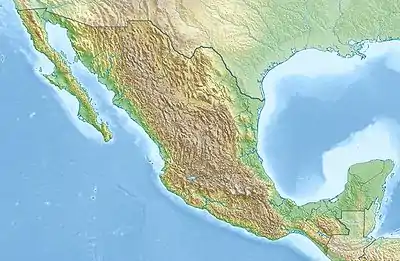Sangangüey
Sangangüey is an eroded stratovolcano standing 2340 meters tall in the Trans-Mexican Volcanic Belt of Mexico. The volcano is located immediately southeast of Tepic in the state of Nayarit in Mexico. There has been no confirmed historical eruptions, although an Indian legend recorded the volcano erupting in 1742. The eruption is believed to be one occurring on a flank cinder cone on the volcano.[1] Within the last 300,000 years however, the volcano has produced 45 cinder cones and lava flows.[2]
| Volcán Sangangüey | |
|---|---|
 | |
| Highest point | |
| Elevation | 2,340 m (7,680 ft) |
| Coordinates | 21.45°N 104.73°W |
| Geography | |
| Parent range | Trans-Mexican Volcanic Belt |
| Geology | |
| Mountain type | Stratovolcano |
| Last eruption | Unknown (possibly 1742) |
References
Wikimedia Commons has media related to Sanganguey volcano.
- "Sanganguey volcano". Global Volcanism Program. Smithsonian Institution. Retrieved 2017-02-04.
- S. A. Nelson; I. S. E. Carmichael (1984). "Pleistocene to recent alkalic volcanism in the region of Sanganguey volcano, Nayarit, Mexico". Contributions to Mineralogy and Petrology. 85: 321–335. doi:10.1007/BF01150290.
This article is issued from Wikipedia. The text is licensed under Creative Commons - Attribution - Sharealike. Additional terms may apply for the media files.
